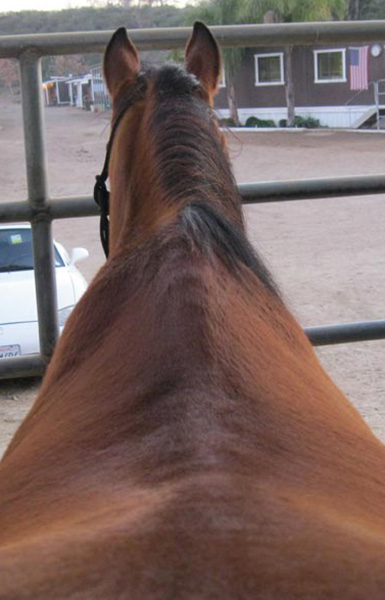Collection has to do with how a horse holds itself together as it is moving. Horses need to be collected in order to move softly on their front ends and drive with their hind ends. In order to have collection, you must first have impulsion. What is impulsion? Impulsion is the energy that is created in the hindquarters to move the horse forward. If the horse his "pulling" himself along with his forehand, he does not have impulsion. When he is instead "pushing" with his hindquarters to get forward movement, he has impulsion.
What does collection look like? It starts with a rounded back which is achieved by a level to low headset. The hind quarters in turn come up under the horse and help move it forward.
Now lets link this to barrel racing. When your barrel horse has its head held high, it is not using it hindquarters and is very hard in the mouth.
However, when we get a horse to soften and drop their heads the picture is quite a bit different.
So the big question is how do we achieve it?
There are several ways but in order for a horse to be collected it needs to have its head down and nose in. I believe that the best method is to teach collection from the beginning however sometimes we need to force it on horses when they compete. Lets start by looking at a few training devices that help teach a horse to be collected.
The German Martingale

The Running Martingale

Draw Reins
Each device works on the principle of changing the direction of pull coming from the reins/riders hands. Which device you choose to use depends on you and your horse, they do not all work on different horses.
The German and Running martingales work on the principle of a set head height. They allow the head to move freely when it is below a certain height however, when the head comes above that height they abruptly stop it. They can be used as either a safety device or as a training device depending on how it is being used.
Draw reins on the other hand provide constant inward pressure. Depending upon where the non bit end of the reins is attached determines whether the pressure is more inward or downward. Draw reins allow a rider to control the horses headset and adjust it based upon what they are doing. The rider has the ability to give the horse more freedom or to pull it in and take the freedom away.
The effect of martingales can be achieved by rider using precise pressure and rapid release. The martingales are simply an option to help achieve the desired results of a soft and supple horse. A good exercise for softening a horses mouth is to apply even pressure with both reins, when the horse gives to the bit immediately release the reins. This method offers a reward for yielding to the bit and giving when asked.

Now that we have discussed some training techniques for softening a horse and helping them start to collect lets discuss some competition aids. Many barrel horses get high headed when entering the ring or in their turns. Neither is a good thing and both can be helped with the use of a tie down.
There are many variations and they all work a little differently. The type of tie down needed depends on the horse, some use them to balance and they need softer ones that allow them to push against them without hurting themselves. Horses who do well at keeping their noses in and are soft in the mouth benefit from a bonnet style which only goes over the ears.
No matter the style that you chose its important to make sure that it is properly adjusted. I see many horses that have tie downs and need them but are not adjusted. When the tie down is not adjusted it does not do its job. The tie down keeps the head down and forces the horse to engage its hind quarters.

The above photo shows a horse with its head in a neutral position. When the horse is standing in neutral position the tie down strap should come tight when pressed up against the horses throat. A loose tie down does not help a horse, neither does one that is too tight on a horse.
From the Author:
Everyone has an opinion on the use of tie downs and other devices that alter a horse's head carriage. My personal opinion is that the riders hands can make any device good or bad. An inexperienced horseman can make even the softest of bits hurt. An experienced horseman with soft and controlled hand movements can make a harsh bit soft. I believe it is less about the devices being used and more about the hands of the rider.





